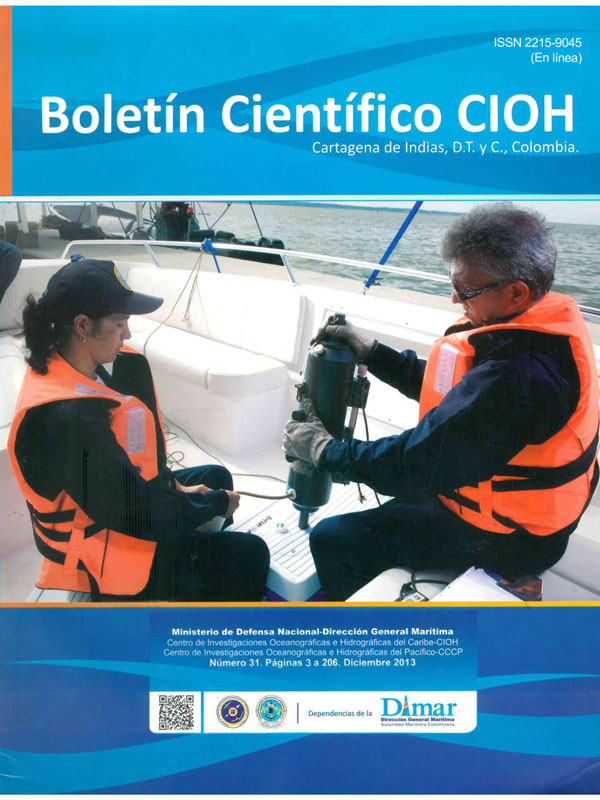Current influence on the wave fields in Bocas de Ceniza, Colombian Caribbean
DOI:
https://doi.org/10.26640/22159045.259Keywords:
Magdalena River, Bocas de Ceniza, currents, wind waves, SWAN, H2DAbstract
The Magdalena River, in Colombia, is the major route of access to the port of Barranquilla. There fore, in order to optimize maritime activities in that region it is vital to focus academic studies on the river behavior, and those related to the entrance to the port. The area of Bocas de Ceniza, at the mouth of the river, is affected by the ever changing hydrodynamic and morphodynamic processes. Thus, two numerical models: Simulating Waves Nearshore, SWAN, and Bidimensional Hydrodynamic model, H2D, simulated (at a distance of approximately 2 km from Bocas de Ceniza into the channel) effects of local currents in the wave fields. Within the access channel a variation in wave height is produced due to the difference in currents’ speed between the outer and the inner part of river-mouth dikes; in the early section the speed of current is as high as 0.1 m/s up to 0.2 m/s. Mean while, in the inside area it ranges from 1.2 to 1.8 m/s. Moreover, the values of wave height may vary from 0.24 m to 1.3 m depending on the caudal. This has not been documented in the literature within a local context, although it is important for future regional forecasts. Additionally, it is crucial in evaluation of oceanographic conditions of access to the Port of Barranquilla, as it affects navigation safety.Downloads
References
[2] Ercilla G., Alonso, B., Estrada, F., Ghiocc, F., Baraza, J. y Farán, M. 2002. The Magdalena turbidite system (Caribbean Sea): present - day morphology and architecture model. Marine Geology. Vol. 185:303318.
[3] Restrepo Ángel, J. D. 2005. Los sedimentos del río Magdalena: reflejo de la crisis ambiental. Medellin: Universidad EAFIT. 9: 221.
[4] Condiciones generales del puerto de Barranquilla durante abril de 2006. E-004-046-06 [Internet]. Cormagdalena. Universidad del Norte. Ideha. [Citado el 8 de agosto de 2009], Disponible en: http://fs03ejal.cormagdalena.com.co/nuevaweb/
Puertos/E004046%20Sexto%20Inf.%20Mensual%
20%20C%20de%20A-Abr%202006.pdf.
[5] Slutz, R. J., Lubker, S. J., Hiscox, J. D., Woodruff, S. D., Jenne, R. L., Joseph, D. H., Steurer, P.M. &. Elms, J. D. 1985. Comprehensive Ocean Atmosphere Data Set; Release 1. NOAA Environmental Research Laboratories, Climate Research Program, Boulder, CO, 268 pp. (NTIS PB86 - 105723)
[6] Tejada, C. y González, M. 2003. Desarrollo de un módulo informático para el manejo de datos de oleaje visual para las aguas jurisdiccionales colombianas. Boletín Científico CCCP No.9: 88-98
[7] Agudelo, P., Restrepo, J., Molares, R., Tejada, Torres, R., Osorio, A. 2005. Determinación del clima de olaje medio y extremal en el Caribe colombiano. Boletín Clentífico CIOH No. 23: 41-55.
[8] Booij, N., Haagsma, I. J., Holthuijsen, L., Kieftenburg, A., Ris, R., vander Westhuysen, A. & Zijlema, M. 2007. SWaN User Manual, Cycle III Version 40.51. Delft University of Technology, Netherlands, 115 pp.
[9] Olabarrieta, M., Medina, R. y Lomóco, P. 2005. Efecto de la interacción ola-corriente en la propagación de la marea en estuarios. Ingeniería del agua, Vol. 12, No. 4: 329-344.
[10] Rusu, L. & Guedes, C. 2011. Modelling the wave-currenti nteractions in an offshore basin using the SWaN model. Ocean Engineering, Vol. 38: 63-67.
[11] Phillips, O.M. 1977. The Dynamics of Uper Ocean. Cambridge University Press, Cambridge.
[12] Peregrine, D.H. Interaction of water waves and currents. Adv Appl Mech 1976; Vol.16: 9-117
[17] Moffat and Nichol International. 2006. Obras de profundización del canal de acceso al Puerto de Barranquilla, Colombia. Modelo de propagación de oleaje.
[18] Stronach, J., Zaremba, L., Wuong, M., Neil, L. & McLennan, N. 2006. Wave and current forecast system for the mouth of the Fraser River. Hay and Company Consultants, Vancouver, 15p.
[19] vander Westhuysen, A. J. 2011. Improved Modelling of Wave-Current Interaction in SWaN. Coastal Engineering Proceedings, 1(32), waves-45.
Downloads
Published
Issue
Section
License
Attribution — You must give appropriate credit, provide a link to the license, and indicate if changes were made. You may do so in any reasonable manner, but not in any way that suggests the licensor endorses you or your use.
NonCommercial — You may not use the material for commercial purposes.
NoDerivatives — If you remix, transform, or build upon the material, you may not distribute the modified material.
No additional restrictions — You may not apply legal terms or technological measures that legally restrict others from doing anything the license permits.



